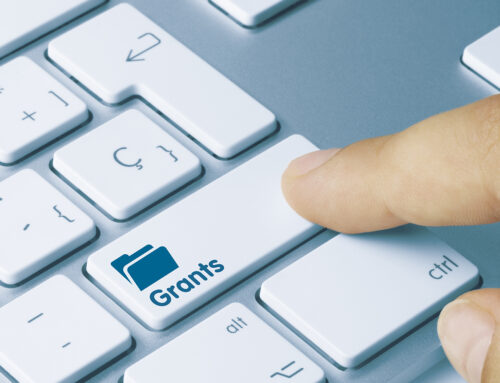 Grants can be a vital component of a successful fundraising plan and generate a big chunk of income for your nonprofit.
Grants can be a vital component of a successful fundraising plan and generate a big chunk of income for your nonprofit.
But if you don’t know what you’re doing, it can be hard and those grant awards can be elusive.
So, what does it take to get grants? What do the successful grant writers know that others don’t?
Here are four keys to becoming a success in getting grants for your nonprofit. Start by mastering these four things and you’ll gain a huge advantage over your competition.
1. Do Your Homework…Know Your Numbers
Simply put, “your numbers” are the things you should be measuring at your nonprofit to help you understand how well you’re doing at carrying out your mission.
They’re also one of the top ways to illustrate your nonprofit’s success.
Now, there are LOTS of numbers you can collect (and should be collecting), but the ones that are primarily helpful in securing grants are those foundational to the success of your programs and projects.
These are the ones you can benchmark year after year to assess and evaluate what you’re accomplishing. Some people call these metrics. Others call them key performance indicators or outcomes. What you call them isn’t nearly as important as knowing what they are and measuring them consistently.
But what are they EXACTLY?
They’re your activity and impact numbers. Here are a few examples:
| Activities | Impact |
|---|---|
| 100 youth attended after-school program | 80% of these youth reported increased self-esteem when their time in the program ended |
| 200 mid-wives were trained between 2008 and 2011 | 10% reduced maternal mortality rate from 2012 to 2017 |
| 480 rescued dogs received proper medical care | 97% live release rate for the previous year |
| 10 low-income families received home ownership education | 90% of these families have remained homeowners for over 5 years |
Knowing your numbers means understanding how prevalent and severe the need is that you’re trying to solve.
Knowing there’s a problem isn’t enough when it comes to grants. You must tell the funder the extent of the problem in your geographic service area and then shine a light on how you’re improving the situation.
 By researching and finding relevant data and statistics – and illustrating how your nonprofit is affecting these (i.e. by providing your impact numbers) –you can get the attention of a funder and demonstrate your ability to make an impact.
By researching and finding relevant data and statistics – and illustrating how your nonprofit is affecting these (i.e. by providing your impact numbers) –you can get the attention of a funder and demonstrate your ability to make an impact.
Grant funders want to invest in nonprofits that are effective at addressing problems and make a positive difference in community needs.
Successful grant seekers are committed to collecting, tracking, monitoring, evaluating, and sharing their numbers because these are evidence that what their nonprofit is doing is working!
2. Be Clear About the Big Picture
Where you’re going, how you’re going to get there, and how much it’s going to cost – these three concepts are vital for grant success (and overall nonprofit success, too!).
Successful grant seekers are proactive and take time to figure out where they want their nonprofit to be one, two, or even three years from now. Maybe they want to start a new program. Or maybe they want to grow or replicate an existing one. Whatever it is, they start early trying to figure things out; they do intentional planning around their ideas to set goals; and then they find the money to make it happen.
In other words, they’re very strategic.
They don’t seek out grants simply to get the money or to start a new program just because there’s a grant available. They go after grants that fit their nonprofit’s strategic initiatives.
Plans – Without a plan, how do you know where your nonprofit is headed? When preparing a grant submission, you should be thinking about activities your nonprofit will complete in about 6 – 12 months (sometimes longer). For this very reason, it’s imperative that everyone’s on the same page and agrees with what your nonprofit is proposing to do….because if you’re awarded the money, funders will expect you to carry out those plans!
 Goals – Your nonprofit’s overarching goals should be a natural extension of your plans and get you thinking and moving forward. Consequently, they provide the framework for determining your programs’ goals and activities so your nonprofit gets where it wants to be, year after year. In turn, these plans and goals serve as guides for a grant writer as he/she is putting together a grant application.
Goals – Your nonprofit’s overarching goals should be a natural extension of your plans and get you thinking and moving forward. Consequently, they provide the framework for determining your programs’ goals and activities so your nonprofit gets where it wants to be, year after year. In turn, these plans and goals serve as guides for a grant writer as he/she is putting together a grant application.
Budgets – To financially operate your nonprofit, you need to know how much things are going to cost and where the money’s coming from to pay for them. This is also something a funder wants to know before they choose to invest in you and your programs. Budgets are extremely common documents funders require.
3. Ensure Sufficient Infrastructure is in Place
I won’t lie: from start to finish, grants can be complex, and they require a lot of resources. But putting people and systems in place gives you the right tools and proper support to be successful at getting grants.
Sure, having a great grant writer on the front end– someone who has the time, knowledge, and skill to prepare submissions – is a really good start. But how about the team of folks needed to manage grants once they’ve been awarded to a nonprofit? Let’s take a moment to explore areas impacted by grants:
- Program staff should be providing input on goals and budgets for grant submissions. They’re the individuals who will carry out activities funded by grants, provide direct service, and capture and assess metrics relevant to program performance, as proposed in the grant. They may even capture stories and pictures to share with funders because they’re “out in the field.”
- Communication staff help share the news about awarded grants, utilizes social media to share success stories resulting from grants, and helps ensure funders are acknowledged (as requested).
- Accounting staff takes on financial oversight of grants – ensuring they’re accounted for properly in a nonprofit’s accounting system and that spending is taking place in a timely and appropriate manner and expenses are being tracked.

And it takes someone to make sure all these pieces are occurring and no one’s letting things slip through the cracks (i.e., a grant manager). That can be easy to do when you don’t have anybody charged with coordinating the grants.
Systems are just as important as personnel (whether employees or volunteers) to grant success – technology, policies and procedures, information management, facilities, human resources, and even your Board of Directors can directly impact your ability to be successful in getting and managing grants.
4. Do More Homework…Know Your Prospects
Foundations form because they feel compelled to take action to solve a problem in the community – just like nonprofits. In fact, they can be just as passionate about finding solutions as nonprofits.
But they’re not just “cash cows” that exist out there to be a funding stream for nonprofits. They prefer partnering with effective organizations that help them reach their own goals and make positive, lasting impact.
The trick to putting together a list of hot grant prospects that may be willing to partner with you is to have a great fit between the funder’s interest and your needs. Use the Three-Way Fit Test to make sure your nonprofit and the funder are a match with these three characteristics:
- Geographic Fit – Funders choose to support nonprofits located in certain geographic areas. This may be a city, particular region, or state. If they don’t fund your area, you’re not very likely to get a grant.
- Programmatic Fit – Consider their mission, goals, and areas of interest and make sure that what your nonprofit does aligns with these. Otherwise, you’re not likely to get a grant.
- Philanthropic Fit – Do they provide the same type of funding you need, whether it’s for programs, projects, general operating support, capital, and so on?
Whether you’re using grant databases, researching funders through internet searches, or checking out grant newsletters, this test will help you identify solid grant leads.
The Bottom Line
 The bottom line here is to take the grant process seriously and think of it as a long-term source of revenue. You won’t be very likely to find fast cash through grants or funders that will give just because your organization is a nonprofit.
The bottom line here is to take the grant process seriously and think of it as a long-term source of revenue. You won’t be very likely to find fast cash through grants or funders that will give just because your organization is a nonprofit.
Be prepared to do some planning on the front end and follow the process all the way through to give the funder the follow-up they want. That’s what separates a successful grant seeker from those who struggle.






Great post, as i am very new to this fundraising thing.
Currently im runing my own campaign to help homeless cats in my area
if you interested to help you can check my campaign here https://fundrazr.com/a1VXgb?ref=ab_f89PI1
I really appreciate your help 🙂
Thank you!